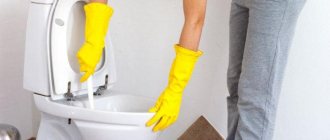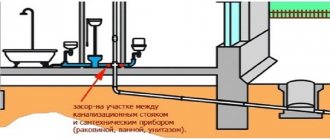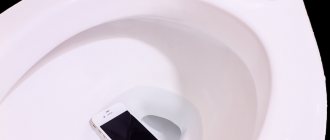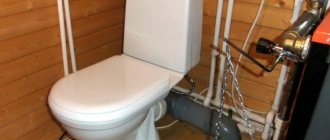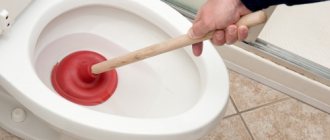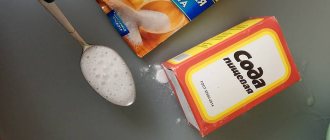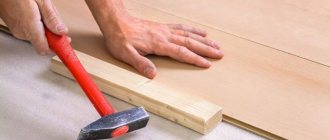Clogs are the most common plumbing problem. It can be caused by deposits of hard water salts, organic sediments and other debris that gets into the sewer pipe, narrowing its internal opening.
In some cases, a clogged toilet is the result of the actions of apartment owners who dump leftover food, fermented household ingredients and dirty water into it after cleaning the room. How to diagnose a blockage and what to do if the toilet is clogged without involving expensive specialists, let’s try to understand this material.
Types of blockages
The following problems with drainage may occur:
- A situation often occurs when biological waste, which is the result of human activity, does not go into the sewer pipe along with the flushed liquid, but, on the contrary, pours out. This means that you need to make a decision if the toilet is clogged - what to do at home.
- Events may develop differently. The problem is that the wastewater does not go in the usual direction, but begins to flow out through the drain hole of the sink, bathtub or other plumbing fixtures. Usually this happens not through the fault of the residents of the apartment where the accident occurred, but because the riser is clogged by neighbors living on the floor above. To deal with the problem that has arisen, you should ask them and find out if everything is in order with their drainage. When the riser becomes clogged, then only plumbers who have access to the sewer networks of a particular apartment building can remove the blockage.
What can cause a clogged pipe?
Thick paper, newspapers, unshredded food waste, rags, sponges, congealed fat, any objects that accidentally fell into the drain, clumps of hair, plastic bags, used hygiene products.
Recently, clumping chemical cat litters have been added to the usual causes of pollution..
Such products literally cement the sewer, creating complete obstruction. In this case, only professionals can clean the pipes using special means.
To avoid sewer obstruction, it is highly advisable to place a convenient bucket with a lid for paper waste in the toilet. If all neighbors in the riser do the same, the likelihood of traffic jams in the sewer will be minimized.
Causes of blockages
There are several reasons why the toilet becomes clogged:
- The most common one is filling the bowl with a lot of paper. Often completely foreign objects get into the device - rags, children's toys, feminine hygiene products, etc.
- Often, when the toilet is clogged, you have to decide what to do at home as a result of the fact that it was not installed correctly. The reason for the problem is that when laying pipes, the angle of inclination relative to the riser must be observed, as well as the optimal distance between it and the device.
- The absence of elements that equalize the pressure in the pipes during the draining process, such as valves or a drain pipe.
- Ill-conceived design of plumbing equipment, if its production was carried out using a handicraft method.
Features of home sewerage
Sewage is an integral part of the drainage and water supply system. It is designed to remove liquid and solid products of human activity, to purify household water from contaminants and return them for further use or into a reservoir. A sewerage system is necessary for comfortable living in a house or apartment.
Residents of apartment buildings are responsible for the condition of sewer pipes in the apartment, and owners of private properties must independently install local treatment facilities, remove sewage, and maintain pipelines and equipment.
In order to avoid unpleasant problems in the future, you should comply with the requirements of SNiP regulations on water drainage and sewerage. Then the system will work normally, without requiring constant monitoring or adjustment.
Having a properly designed and installed sewerage system will make life more comfortable, help maintain environmental balance on the site and extend the life of buildings
The internal sewer networks include:
- plumbing fixtures with water drainage;
- common riser which sewer pipes are connected;
- pipe layout that ensures the process of transporting wastewater from the drain hole to the riser.
Requirements for internal networks are specified in SNiP “Internal sewerage”, in GOST and SNiP “Sewerage”. The systems are installed inside the building and ensure the transportation of all wastewater from the place of its formation to the pipe exiting the building.
Basic requirements for internal networks:
- When installing plumbing fixtures on drains, a water seal is required.
- Cast iron or plastic pipes are used for laying networks.
- The diameter of the sewer system outlet from the house is at least 110 mm.
- When laying pipes, a slope of 2 to 2.5% must be maintained.
The internal networks of the sewer system must be equipped with ventilation. The process of ventilating the networks is carried out through common sewer risers - an exhaust part is installed, leading to the roof.
The main reason for clogged sewer pipes in the bathroom is a significant accumulation of fat and other deposits on the inner surface of the pipe.
Due to the resulting blockages, normal drainage of wastewater becomes impossible, so it is necessary to immediately resume the full functioning of the sewer system. In order to avoid unpleasant consequences due to a blockage in the pipeline, you need to call specialists or clean the sewer yourself.
Options for cleaning toilets
Popular ways to eliminate the problem of what to do if the toilet is clogged are to use:
- hot water;
- soda
Hot water is used as the only option if there are no special means at home, and the toilet is clogged - the owner does not know what to do. To do this, you will need to boil a bucket of water and immediately pour it into the bowl of the device at a right angle, acting quickly and thereby creating pressure.
If it becomes clear that the liquid is gradually leaving, which means that the blockage has been eliminated, in order to enhance the positive result, you can additionally use another bucket of boiling water. This method is good for removing small traffic jams.
As for soda, it is available in every home, since housewives use it in many situations and when the toilet is clogged, and you need to figure out what to do at home quickly. You should pour half of the regular package of soda directly into the bowl of the device. As a result, the blockage will dissolve under the action of alkali.
Chemical methods for cleaning pipes
Hot water
If you are confident in the quality of your plumbing, try unclogging your toilet by pouring a bucket of hot water into the toilet. Be careful, the water should be hot, but not boiling water . You need to fill the toilet to 80% and wait a couple of minutes, then try to break through the blockage with a plunger or simply flush the water.
By the way, this method works great if you clog the toilet with cat litter.
A simple way - a bucket of hot water with soda
A bucket of water will require about half a pack of soda.
This is a rather aggressive composition, but it will not be able to cause damage to pipes.
Baking soda effectively dissolves various organic contaminants and fats.
By the way, soda washes away burnt fat no less effectively than vaunted branded gels.
Another thing is that soda can simply clean off a Teflon surface due to its slight abrasive effect.
If the cork is soluble, then a hot soda solution will remove it.
Mole and its modifications
Acid-based products do not dissolve blockages, but they can seriously damage the pipes.
“Mole” is practically not suitable for cleaning the toilet due to the presence of a water lock.
“Mole” will get into the pipe, that is, into the workplace only in a very diluted form , which is absolutely unable to dissolve the blockage, but will completely damage the pipe.
Why are acid products not effective? The answer to this question lies in the chemistry course of the 8th-9th grade of high school and in the selective action of various acids. Acids that dissolve organic matter do not dissolve polyethylene, and it is plastic bags that cause half of the blockages.
Acids that dissolve polyethylene do not dissolve organic matter, but easily dissolve plastic sections of pipes and some metal structures.
The use of "Mole", effective in past decades, before the significant proliferation of plastic packaging, was very effective.
Currently, “Mole can be successfully used to dissolve organic blockages in the sewers of private houses.
Fairy tricks
It’s better to really pour half the bottle of “fairy” down the toilet. If the blockage is fatty, “fairy” will dissolve it without difficulty. But grease clogs, which are common in kitchens, are quite rare in fecal drains.
It is highly undesirable to flush shampoos and regular foaming detergents down the drain.
Folk remedies “Pepsi and cola”
Effectively removes yellow plaque and stains from plumbing fixtures. This is true. This is where the benefits of these drinks end.
Of the presented remedies, the most effective is a solution of baking soda in hot water..
We will not consider options with a bleach solution and pouring bottles of “whiteness” into the sewer.
Chlorine solutions are effective in preventing blockages when used regularly.
Several decades ago, disinfection of sanitary facilities with chlorine was a mandatory procedure in all public places.
In clinics, hospitals, first aid stations, government agencies. This procedure was abandoned due to the harmful effects of toxic chlorine fumes on the body. Modern disinfectants have a viscous structure and are characterized by a longer service life compared to liquid solutions and fewer harmful fumes.
Using disinfectants in the toilet flush cistern or bowl reduces the risk of clogs.
Read about installing a toilet on tiles in this article. And here is everything about the air valve for sewerage, types of valves for a private home and installation methods.
Using chemicals when the toilet is clogged
It is much easier to find the answer to the question of what to do when the toilet is clogged if the housewife has specialized tools at hand. Stores that sell household chemicals today offer customers a huge selection of products for cleaning pipes and plumbing fixtures. Also, if you don’t know how to clean limescale in the toilet, you should use one of the chemicals.
They are sold in powders, granules, gels and liquids, not only in single-use packages, but also in large containers or packs that are designed for use several times. These products cope excellently with the problem of what to do if the toilet is clogged.
At the same time, they also perform several important functions:
- Plumbing equipment is not only cleaned, but also disinfected.
- Eliminates unpleasant odors coming from sewer pipes.
- Keep the drainage system clean.
- They have a preventive effect on the surface of plumbing equipment.
Common products used when the toilet is clogged and what to do is clear, are the products of the following brands:
- Mister Muscle;
- Mole;
- Tiret;
- Domestos;
- Tofix;
- Domol.
When using chemical compounds, be sure to follow the rules; if the toilet is clogged, how to clean the toilet. They are specified in the attached manufacturer's instructions. They should be followed to avoid damaging the plumbing and avoiding accidental burns.
Be sure to use rubber gloves. People who are well acquainted with chemistry know, if the toilet is clogged, then what to do at home using various acids, such as hydrochloric, acetic, sulfuric, formic. But it must be remembered that aggressive solutions can damage old sewer pipelines and risers.
The main reasons for a clogged toilet
The main task of the home owner is to promptly identify the problem of clogged plumbing and urgently take measures to eliminate it. If water stagnates in the toilet, it is necessary to act promptly, but first you need to determine whether the water is draining in the remaining sewer units (sink, shower, bathtub).
The main reasons for a clogged toilet:
- “overgrowing” of sewer pipes;
- improper operation of plumbing equipment;
- poor choice of model and errors when installing the toilet.
If the water gradually drains from the toilet, and everything is fine with your neighbors, then the blockage is located no further than the outlet of the main line into the sewer pipe. In case of local clogged plumbing, you can call a professional specialist, or you can try to fix the problem yourself.
The main reason for the slow drainage of water is the “overgrowing” of sewer pipes.
As a rule, minor blockages can be eliminated independently using various methods. Home sewer cleaning: soda, cable, plunger
If the rules of operation of the sewer system are violated or due to sand, grease, hair and other insoluble substances entering the system, a blockage often occurs. The lumen of the pipe decreases and if the problem is not immediately eliminated, then compaction of the drain occurs, causing “paralysis” of the sewerage system.
As a result of clogged plumbing, the water stops partially or completely leaving, and an unpleasant odor appears in the bathroom. In order to eliminate this problem, it is necessary to clean the sewer.
Errors in the installation of plumbing equipment usually occur when choosing the wrong toilet model, which is not structurally compatible with the place where it is installed. The presence of this problem is indicated by an incorrect slope of the water drain line from the plumbing fixture to the riser. In rare cases, the design of the toilet contributes to the formation of blockages.
In order to choose the right quality plumbing equipment that is optimal for your conditions, it is recommended to consult with professional plumbers before purchasing.
A clogged drain in an apartment building is a “public” problem, since it can be initiated by you or your neighbors, and collective participation is not excluded.
Clogging of liquid waste along the route within the apartment is your problem, so it is better to eliminate it yourself. Rags, cat litter, diapers, construction waste and other items that fall into the toilet are not considered liquid waste, so these blockages are quite difficult to remove.
We also recommend reading our other article, where we examined in detail the types of sewer blockages. If you are interested in details, follow the link.
Mechanical methods for clearing blockages
The toilet is clogged with paper - what to do if chemicals cannot be used?
In this case, mechanical options for cleaning plumbing are used, for the implementation of which special devices and various products are used:
- plunger;
- corrugation;
- rubber hose;
- plastic bottles;
- plumbing cable.
It is recommended that every home craftsman have a tool such as a plunger, so that he does not have to call a plumber every time if the toilet is clogged with paper or other debris. Its design is simple - there is an attached rubber hemisphere on a plastic or wooden handle.
What cleaning products are there?
Remedies and methods for toilet blockages can be divided into the following groups:
- 1. Chemicals and rinsing.
- 2. Mechanical means without pipe examination
- 3. Deep mechanical means (plumbing cables)
- 4. Technical. Dismantling of corrugations, a section of pipe, complete or partial replacement of the pipeline. In such cases, it is better to call emergency services.
The common goal of all methods is to clean the clogged section of the pipe and remove contamination.
Help from plumbers if the toilet is clogged
If a home craftsman knows how to deal with the blockage on his own, but the result is not achieved, then the help of a professional is required. Sometimes situations arise when you need to call a plumber immediately.
Only he will determine why there is water in the toilet, despite all the measures taken. Usually the riser below the floor level is clogged. Only a specialist can eliminate the flow of waste flowing over the edge of the toilet bowl.
Mechanical cleaning methods
Mechanical methods for cleaning pipes are generally more effective than chemical methods. There are household methods for clearing blockages, such as a plunger, and more technologically advanced ones for clearing blockages deep inside pipes, using plumbing cables.
Using a plunger
A plunger is an essential tool for effectively clearing small clogs.
The plunger creates hydraulic tension in the pipe, which destroys and pushes most of the contaminants forward.
How to use a plunger?
Take the plunger by the handle, place the suction cup over the drain and perform 5-10 sharp and strong pushing movements. Unstick the plunger and repeat the procedure if necessary.
Usually, several approaches and about 10 minutes are enough to remove the contamination.
After eliminating the contamination, for preventive purposes it is good to pour one or two buckets of warm water with soda into the toilet. The plunger must be kept clean and placed in a disinfectant liquid after use or rinsed thoroughly.
Plastic bottle
In case of emergency, a plastic bottle can replace a plunger.
How to use a pipe cleaner bottle?
The bottom is cut off from a plastic bottle, the cap is screwed tightly, and with the resulting device you can try to create a hydraulic wave, like a plunger.
After use, the contaminated bottle should be immediately disposed of in the trash.
Using a plumbing cable
The plumbing cable for drain cleaning comes in several modifications.
From household devices, no more than 5 meters long, to professional devices, which can easily break through a blockage in a toilet or pipeline.
An ordinary plumbing cable is an elastic, springy metal cable with a handle.
The cable is carefully inserted into the plumbing fixture and rotates, pushing through and destroying the cause of blockages. A metal brush is often made at the end of the cable, with which you can remove the object that caused the obstruction.
Scheme for cleaning a toilet with a plumbing cable
If the cause of the clogged pipe cannot be eliminated, contact the plumbers who service your home. Eliminating the cause of a pipe obstruction can take a long time and require special knowledge and skills.
In order not to take on unnecessary responsibility for flooding your neighbors with fecal matter as a result of unprofessional actions, it is better to seek help from specialists.
Preventive measures
When the question often arises: what to do if the toilet is clogged, you need to remember the rules for handling plumbing fixtures so as not to provoke unpleasant situations with clogging of the sewer system:
- You cannot throw a foreign object at it. If one of the family members accidentally drops something into the bowl, it is advisable to remove it immediately.
- It is prohibited to throw leftover food into the toilet, even when it is liquid. The fact is that fats accumulate on the inner bend and form a plug over time.
- When renovation work is going on in the bathroom, it is better to carefully cover the plumbing fixtures so that construction debris does not get into the fixture.
- In order to prevent blockages, it is necessary to periodically use special means that will keep the pipes clean. When using them, you must follow the manufacturer's instructions.
Homeowners who have had to deal with a clogged toilet - they already know who to call. No one can solve the problem of a clogged toilet better than a plumber.
How is the sewage system arranged in apartments?
Sewage in modern apartments performs the task of removing human waste. For this purpose, a waste disposal line is installed from each point where waste is generated (toilet, sink and bathtub) to a common sewer riser.
Apartments located on adjacent floors are connected to it. The riser is a large pipe with a diameter of 0.1 m, located in the bathroom.
All sewer systems that are built in apartment buildings and private buildings must strictly comply with construction and sanitary standards.
Previously, only cast iron pipes were used for sewerage installations, but now mostly plastic ones are installed. In a plastic pipeline, the possibility of blockages is less likely, since defects do not appear on the walls, and “overgrowing” of the riser section occurs very rarely.
To make it easier to clean the riser in a high-rise, holes are made on each floor - sewer inspections.
The most often clogged cast iron pipes of the sewer system, which are found in older buildings. Overgrown pipes have increased resistance to runoff and are susceptible to external factors
The standard configuration of a plumbing fixture (toilet, washbasin or bathtub) looks quite simple:
- device drain hole;
- siphon (a curved elbow that is connected to the waste disposal line);
- supply pipeline to the riser;
- large pipe or riser.
The blockage can be observed in any area, but it should be borne in mind that the cause of its appearance is man-made. If the plumbing fixture is used for its intended purpose, there should be no problems.
Hangers
One effective homemade device for cleaning clogged toilets is a regular wire hanger. In order to break through the blockage, perform the following steps:
- Straighten the structure with pliers. Leave a hook. It will serve as a handle.
- A rag is tied to the other end of the hanger and secured well so that it does not fly off when cleaning. It will protect the toilet bowl and pipes from damage.
- 60 ml of any dishwashing liquid is poured into the toilet. Wait 5 minutes until the product flows to the clog and lubricates it, which will facilitate the cleaning process. Shampoos and gels are used for the same purpose.
- Rubber gloves are put on your hands. The end of the hanger, wrapped in a rag, is inserted into the toilet. Push it down the drain until it clogs.
- The cork is pierced by making a back-and-forth motion with the hanger.
What not to do
Mistakes in clearing a clogged toilet can make the situation worse. When working, follow the recommendations:
- Follow the manufacturer's instructions. If the remedy does not work, this does not mean that you need to increase the dosage. Most likely, you incorrectly identified the cause of the jam and chose the wrong chemistry.
- Make sure the method is suitable for your type of pipe. Be careful with caustic compounds, such as caustic or soda ash, sulfuric acid. If used incorrectly, the substances can damage the inner surface of the pipes.
- Do not pour bleach or other chlorine-containing products into the toilet - they do not cope with blockages, and their fumes are harmful to health.
How to Clear a Toilet Paper Clog Using Baking Soda
You can remove operational blockages using regular baking soda, which in most cases is available to every housewife.
- Dissolve half a pack of soda in warm water.
- Pour into the toilet drain hole.
- After 2 hours, rinse the toilet with water.
There is a more effective way using baking soda. Since the soda solution is alkaline, if you heat it in a frying pan, it will become more active and will be better able to cope with the blockage. For this you will need:
- 150 g of baking soda (about 5 heaped tablespoons);
- 200 ml water;
- pan.
Step-by-step instruction:
- Pour baking soda into a frying pan and heat over low heat for 15 minutes, stirring continuously. By the end of the process, the release of carbon dioxide should stop, and the soda will become more flowable.
- Remove the pan from the heat and let cool for 10 minutes. This is a prerequisite necessary to prevent burns when the substance is combined with water.
- Pour the resulting powder into a working container and add 200 ml of water to it. Mix well. The sodium carbonate should either completely dissolve in the water or leave a small residue.
- Pour the resulting light brown solution into the toilet drain hole.
- After 2 hours, rinse the toilet with plenty of water.
Baking soda is an effective toilet cleaner
Clearing a toilet blockage with a plastic bottle
You can quickly get rid of a clog in the toilet using improvised means. For example, using a regular plastic bottle with the bottom cut off and the cap tightly screwed on.
- The device must be carefully and slowly inserted into the drain.
- As soon as you feel the air pushing the bottle back, push it sharply to the very end of the drain hole. After this, remove the bottle from the drain with a sharp movement.
The water will go away and the congestion will be eliminated if the procedure is repeated two or three times.
What clogs our toilets?
In order to master the technology of cleaning a toilet and adjacent sewer pipes, you first need to become familiar with its design.
The toilet is a sanitary device, inside of which there is a wastewater receiver, which turns into a curved pipe, the outlet of which is connected to the sewer system. The purpose of bending the pipes in the toilet is to create a water seal, which is designed to prevent unpleasant sewer odors from entering the apartment.
Sample of clogged toilet
As a rule, various large water-insoluble objects get caught in this bend and get stuck. These can be scraps of thick paper, rags and other rags, bags and plastic, and so on. Mostly, such things end up in your toilet due to the actions of your own household members, but in a separate case, in apartment buildings, such items can end up in your section of the sewer system due to the activities of your upstairs neighbors.
How to determine the location of the blockage
The toilet in one of the apartments of a multi-story building may be clogged due to the fault of any of the residents of this building. If a toilet in a private property is clogged, the cause is sought in an area located on the street.
To determine where the blockage has occurred, you need to turn on the water in the bathroom and kitchen. If the water drains quickly and does not linger, then the blockage has appeared in one of the sections of the pipe. If there is a general blockage of the sewer, then water flows poorly in all rooms. In the latter case, you will need the help of a professional.
When do you need a plumber
If you cannot break through the toilet using available means, all methods and means of clearing blockages have not brought results, you need to think about calling specialists. They can inspect the plumbing and determine whether it is necessary to try to restore normal functioning or install new equipment.
This is especially true when the plumbing equipment is old, the drain hole in it is overgrown with a layer of urinary stone by about 15 mm. The plumber will quickly remove a massive dirt plug or remove the stuck object.
The third option is a combination of soda and vinegar
The third cleaning method also includes soda ash, but in addition to it, vinegar and boiling water are used in this case.
- One and a half packs of soda (that is, 750 grams) are poured into the drain area.
- A glass or 0.5 liter of 9% vinegar is poured into it. When vinegar is poured in, a reaction should begin, accompanied by hissing and the formation of foam. This mixture must be left for 20÷25 minutes.
- After waiting this time, pour 2–3 liters of boiling water into the toilet and leave again for 15–20 minutes. After this, you can try rinsing with plain water.
